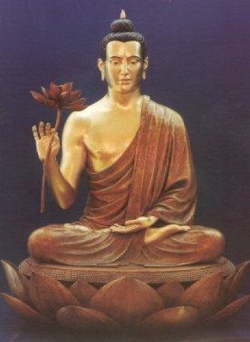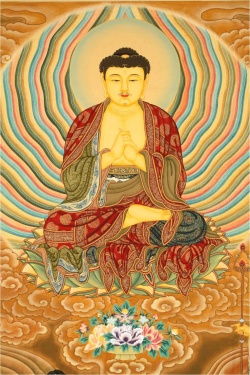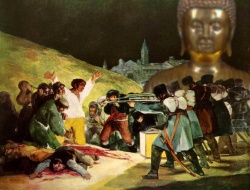The Lamrim Tradition
The Lamrim (Stages of the Path) tradition presents a systematic, step-by-step cultivation of the Buddhist path to enlightenment from the point of view of “the three individuals”.
First it leads students through the stages of the two lower spiritual motivations – individuals who aspire for a better rebirth, and then those who aspire for individual liberation.
It culminates in the presentation of the path for those practicing from the point of view of the highest spiritual motivation,
the Mahayana – those who aspire to attain enlightenment for the benefit of all living beings. Lamrim texts then normally conclude with a brief introductory mention of tantra.
The Lamrim tradition was originated by Jowo Je Atisha (982 – 1054), one of India’s greatest Buddhist scholars,
when he was invited to Tibet with the request to summarise and clarify the key elements distilled from Shakyamuni Buddha’s teachings (the Kangyur) and the Indian commentaries which explain the Buddha’s teachings (the Tengyur).
Atisha’s resulting Lamp for the Path to Enlightenment became the prototype and main textual base for the Lamrim tradition.
It was subsequently adopted by all schools of Tibetan Buddhism.
Following Je Tsong Khapa’s (1357–1419) commentary,
The Great Treatise on the Stages of the Path to Enlightenment, the Lamrim became an integral component of the teachings of the Gelug School.
The series of smaller and larger Lamrim texts by Je Tsong Khapa are now some of the best-known examples of Lamrim.
In addition to these foundational texts, many Lamrim commentaries have been written by Kadam and Gelug lamas, including the eighteen Lamrim commentaries which His Holiness the Dalai Lama taught during the Jangchup Lamrim Teachings.
His Holiness the Dalai Lama, in his Foreword to a modern day Lamrim commentary, had this is say about the Lamrim Tradition:
The Great Treatise on the Stages of the Path to Enlightenment (Lamrim Chenmo), composed by Tsongkhapa and explained here by Geshe Lhundub Sopa, is a commentary on the Lamp for the Path to Enlightenment by Atisha.
The primary goal of these teachings is to discipline and transform the mind.
These texts have their source in the sutras and the other teachings of the Buddha himself, but their special virtue is that they convey the thought of the Buddha in a format that is easy to apply in actual practice.
The authors of these wonderful texts composed them in order to help all living beings.
Since they developed the altruistic attitude to benefit mother sentient beings, we too should follow their example, irrespective of our own weak situation.
The Buddha and the great teachers who followed him gave clear instructions on how to proceed from a state of suffering to a state of peace and happiness.
Following such teachings of the great masters of the past, Atisha summarized them in his famous text, the Lamp for the Path to Enlightenment.
It is a wonderful text, and Atisha’s disciples such as Dromtonpa and Potowa put what it teaches into practice.
It was then transmitted through the Kadam lineages, finally coming down to Tsongkhapa.
He was an unparalleled scholar, who composed the Great Treatise on the Stages of the Path to Enlightenment, the marvelous text explained here in the manner of the great masters of Nalanda monastic university.
We are indeed fortunate after so much time to have access to such a great work and to be able to read and think about what it contains.
With this publication of Geshe Sopa’s commentary, Tsongkhapa’s words are brought to life and illuminated for a modern audience, continuing the lineages of scripture and realization that the Buddha set in motion more than 2500 years ago.
The two principal aspects of practice described here are a proper understanding of emptiness and the awakening mind of bodhicitta.
A correct understanding of the view of emptiness is very important, for whether you are taking refuge, or cultivating the awakening mind of bodhicitta, all other practices are enhanced by such an understanding.
At the same time, it is extremely important that our insight into the ultimate nature of reality is supported by compassion and the awakening mind of bodhicitta.
In my own case, regardless of my limited capacity, I try my best to develop these two minds: the wisdom understanding emptiness, and bodhicitta—the wish to achieve enlightenment for the sake of all sentient beings.
Merely trying to approach and cultivate these two minds brings greater peace and happiness.
The development of these two minds is really the heart of Buddhist practice.
It is the essential meaning of this Stages of the Path to Enlightenment.
If we were to examine all the sutras and words of the Buddha, along with the subsequent treatises that are commentaries to them, we would find that they can be summed up in these two practices.
Therefore, we should study these teachings motivated by an aspiration to achieve enlightenment for the sake of all sentient beings.
Today, Buddhism is spreading throughout the Western world, encountering new cultures and new languages.
During such a period of transition it is very important that the Dharma be transmitted by scholars and practitioners who possess a deep and vast understanding of the teachings, because that is the only way to protect the authenticity and purity of the teachings.
Atisha exemplified this role by bringing the pure teachings from the great monastic centers of North India and establishing them in Tibet in an authentic and complete form that was, at the same time, suitably adapted to the Tibetan personality.
He reestablished monasticism in Tibet and emphasized ethical conduct as the heart of Buddhist training.
He dispelled the many misconceptions and erroneous customs that had entered the practice of the Dharma in Tibet.
In this way he reestablished the pure Buddhadharma in many places where it had been lost, and enhanced it where it survived.
Requested by Jangchub Ö to give a teaching that would be beneficial to the Tibetan people in general, Atisha composed the Lamp for the Path to Enlightenment, which condensed the essential points of both sutras and tantras into a step-by-step method that would be easy to follow. This text inaugurated the grand tradition of the study and practice of the stages of the path method in Tibet.
Tenzin Gyatso, the Fourteenth Dalai Lama September 23, 2002
© His Holiness the Dalai Lama, 2005. Foreword. Reprinted from Steps on the Path to Enlightenment: A Commentary on the Lamrim Chenmo, Volume 1: The Foundation ctices by Geshe Lhundub Sopa with David Patt with permission from Wisdom Publications, 199 Elm Street, Somerville, MA 02144 USA.
Source
https://www.jangchuplamrim.org/jangchup-lamrim/lamrim-tradition/




